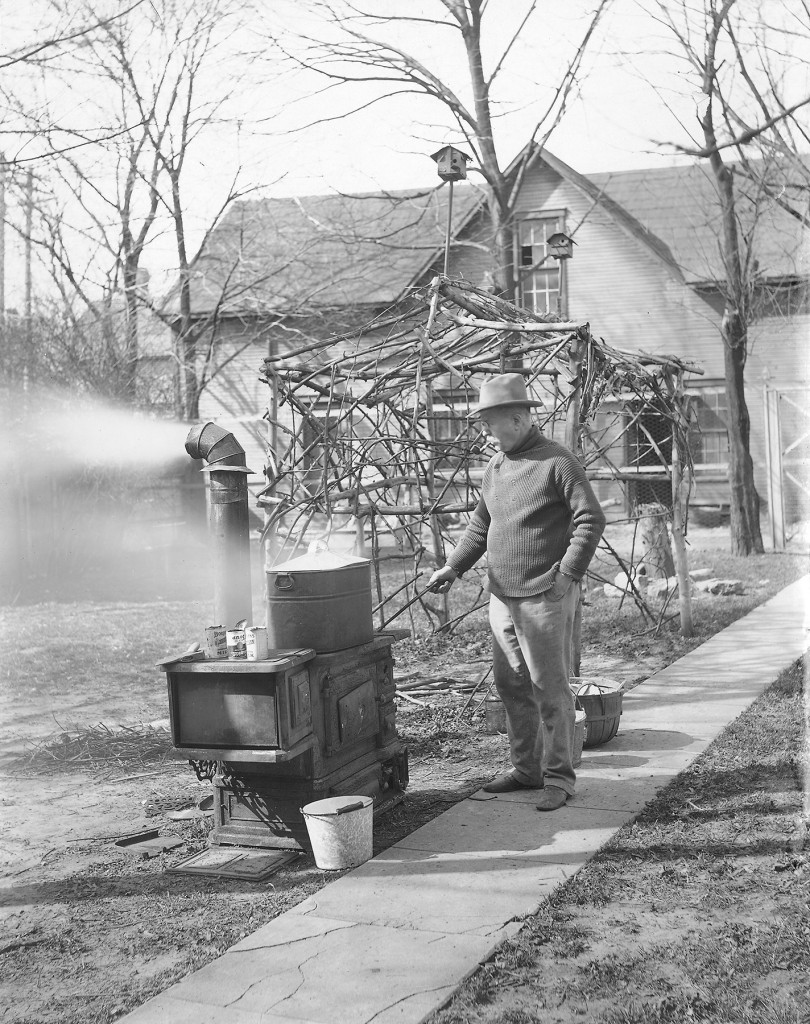Two years ago as part of our 1913 Flood centennial commemoration, we told the story of Dayton’s 1913 flood day-by-day through the diaries and letters from our collections. Among these were items from the Neukom family: letters from Edward and Nellie, which could often be “illustrated” using photographs taken by their son Everett.
One such combination involves Edward Neukom cooking on April 6, 1913, days after the flood water had receded. In part of letter to her sister, wife Nellie wrote:
…we are all three safe & well—House safe—I am tired out & Edward is cooking—Everett took a photo of him out in the yard… The natural gas is promised for tomorrow—We have had water since sat. a week ago…
This is the referenced photograph, showing Edward Neukom cooking out in their yard:

Edward Neukom cooking on his stove in the yard, April 6, 1913. Photo by Everett Neukom (ms128_3-1-11).
It is interesting what this photograph can show us, even though we have the letter to accompany it. We know that their natural gas is still out—the letter says so—so I think we can assume that is the main reason that Edward is cooking on a stove outside. (One might guess another possible reason is that the house is still a wreck, except we happen to know that the Neukom’s Dayton View home was not actually flooded, so their flood-related hardships and losses were considerably less than those of many others in the area.)
Edward is using a wood-burning stove, but where did it come from? Perhaps this was their old stove before they replaced it with a gas model, and it had been relegated to the garage—and hauled out to resume service for the duration of the gas outage? The pile of kindling in the background to the left, the ax on the corner edge of the stove, and what appears to be an ash bucket (or, given the absence of a shovel, perhaps a bucket of dirt for emergency fire suppression?) add to the visual story.
Perhaps the most interesting tidbit in this photograph are the empty cans sitting atop the stove, which, if we zoom in on the original high resolution image, we can read:
There are two cans of Borden’s Peerless Evaporated Milk. And I think we all recognize the trademark packaging of the can in the center, even upside-down, but let’s see what it looks like right-side-up:
It’s a can of Campbell’s Mock Turtle Soup!
Now, if we didn’t already know the exact date of this photo, these cans might possibly be a useful source of helping us guess the date (in addition to the much simpler clue—what are people in the photo wearing?). You could try to research when certain products were developed, when they became available in the area, when the products were discontinued, when their packaging appeared as it does in the photo, etc. Although, come to think of it, canned goods might complicate this process, as the whole purpose of canning food is so that it stays good longer—perhaps for years after it was originally purchased.
The Borden Company has been around since the 19th century, as has the Campbell’s Soup Company. So perhaps if you needed to use these to help you date the photo, it would be most helpful to focus on the packaging itself or perhaps the time frame during which Campbell’s made and sold “mock turtle soup” (which they no longer do).
(The History Channel has a blog post about “The Rise and Fall of Turtle Soup” and why “mock turtle” soup came about.)
Something else of interest, with regard to the empty cans, is how large that stock pot is compared to the contents of the three cans he has presumably just emptied into it. Are there more empty cans somewhere that we just can’t see? Or has he added lots of water to make the soup “go farther”? (According to Nellie’s letter, their water was already up and running.) Or maybe that was just the first pot he happened upon?
And what is that in his hand? It’s not a spoon. It’s more like a stick. And what are those buckets and baskets just behind where he’s standing?
What other questions do you have about this photograph? What else can you find? What does it make you wonder about? Can you come up with any possible explanations or even guesses about your own questions or one we’ve mentioned here?


